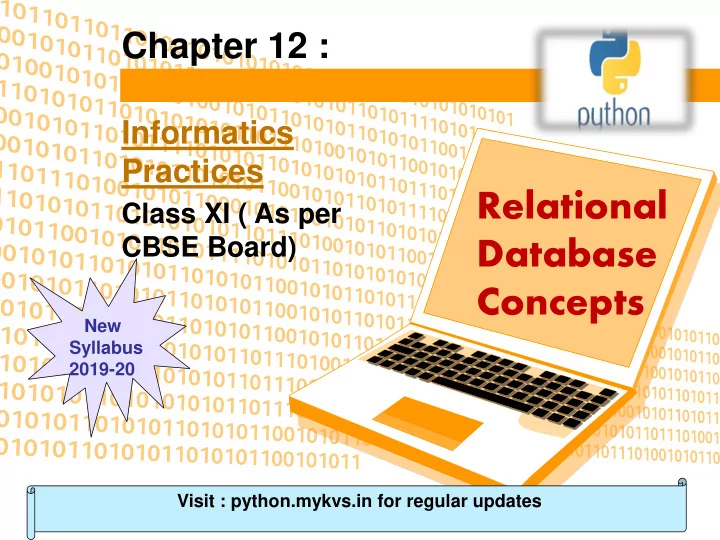

Chapter 12 : Informatics Practices Relational Class XI ( As per CBSE Board) Database Concepts New Syllabus 2019-20 Visit : python.mykvs.in for regular updates
DATABASE CONCEPTS A database is a collection of DATA/INFORMATION that is organized so that it can be easily accessed, managed and updated. In Database ,Data is organized into rows, columns and tables, and it is indexed to make it easier to find relevant information. It works like a container which contains the various object like Tables, Queries, Reports etc. in organized way. Visit : python.mykvs.in for regular updates
WHY DO WE NEED DATABASE To manage large chunks of data: if size of data increases into thousands of records, it will simply create a problem to manage.Database can manage large amount of data. Accuracy: Through validation rule in database ,data accuracy can be maintained. Ease of updating data: With the database, we can flexibly update the data according to our convenience. Moreover, multiple people can also edit data at same time. Security of data: With databases we have security groups and privileges to restrict access. Data integrity: In databases, we can be assured of accuracy and consistency of data due to the built in integrity checks and access controls . Visit : python.mykvs.in for regular updates
DBMS Database Management System(DBMS) A DBMS refers to a software that is responsible for storing, maintaining and utilizing database in an efficient way. A Database along with DBMS software is called Database System. Example of DBMS software are Oracle, MS SQL Server, MS Access, Paradox, DB2 and MySQL etc. MySQL is open source and freeware DBMS . Visit : python.mykvs.in for regular updates
DBMS Advantages of Database System Databases reduces Redundancy It removes duplication of data because data are kept at one place and all the application refers to the centrally maintained database. Database controls Inconsistency When two copies of the same data do not agree to each other, then it is called Inconsistency. By controlling redundancy, the inconsistency is also controlled. Database facilitate Sharing of Data Data stored in the database can be shared among several users. Database ensures Security Data are protected against accidental or intentional disclosure to unauthorized person or unauthorized modification. Database maintains Integrity It enforces certain integrity rules to insure the validity or correctness of data. For ex. A date can’t be like 31/31/2000. Visit : python.mykvs.in for regular updates
DBMS Data Model- Way of data representation Data model is a model or presentation which shows How data is organized ? or stored in the database. A data is modeled by one of the following given- Relational Data Model In this model data is organized into Relations or Tables (i.e. Rows and Columns). A row in a table represents a relationship of data to each other and also called a Tuple or Record. A column is called Attribute or Field. Network Data Model In this model, data is represented by collection of records and relationship among data is shown by Links. Hierarchical Data Model In this model, Records are organized as Trees. Records at top level is called Root record and this may contains multiple directly linked children records. Object Oriented Data Model In this model, records are represented as a objects. The collection of similar types of object is called class. Visit : python.mykvs.in for regular updates
RELATIONAL DATABASE A relational database is a collective set of multiple data sets organized by tables, records and columns. Relational database establish a well-defined relationship between database tables. Tables communicate and share information, which facilitates data searcheability, organization and reporting. A Relational database use Structured Query Language (SQL), which is a standard user application that provides an easy programming interface for database interaction. Visit : python.mykvs.in for regular updates
RELATIONAL DATABASE TERMS Visit : python.mykvs.in for regular updates
RELATIONAL DATABASE TERMS Relation (Table) A Relation or Table is Matrix like structure arranged in Rows and Columns. It has the following properties- Atomicity : Each column assigned a unique name and must have atomic(indivisible) value i.e. a value that can not be further subdivided. No duplicity: No two rows of relation will be identical i.e. in any two rows value in at least one column must be different. All items in a column are homogeneous i.e.same data type. Ordering of rows and column is immaterial. Domain :It is collection of values from which the value is derived for a column. Tuple / Entity / Record - Rows of a table is called Tuple or Record. Attribute/ Field- Column of a table is called Attribute or Field. Degree - Number of columns (attributes) in a table. Cardinality - Number of rows (Records) in a table. Visit : python.mykvs.in for regular updates
KEYS IN A DATABASE Key plays an important role in relational database; it is used for identifying unique rows from table & establishes relationship among tables on need. Types of keys in DBMS Primary Key – A primary is a column or set of columns in a table that uniquely identifies tuples (rows) in that table. Candidate Key – It is an attribute or a set of attributes or keys participating for Primary Key, to uniquely identify each record in that table. Alternate Key – Out of all candidate keys, only one gets selected as primary key, remaining keys are known as alternate or secondary keys. Foreign Key – Foreign keys are the columns of a table that points to the primary key of another table. They act as a cross-reference between tables. Visit : python.mykvs.in for regular updates
KEYS IN A DATABASE Visit : python.mykvs.in for regular updates
Recommend
More recommend